Over the course of the past year, the customer support landscape has changed for good.
As brick-and-mortar businesses closed worldwide, companies and customers alike had to pivot to digital-first ways of doing business. As a result, we’ve seen some major, long-lasting changes to how businesses and consumers communicate and build relationships with one another:
- The popularity of messaging channels is on the rise – messenger-based support is now the second most used support channel.
- Most support teams have seen an influx of support queries since COVID-19 hit – and those issues are more complex than ever.
- Delivering an exceptional customer experience is business-critical – and that means that there’s no going back to the outdated, inefficient customer support channels of old.
According to recent research, however, many teams aren’t sufficiently equipped to meet these new challenges. In a commissioned study by Forrester Consulting on behalf of Intercom undertaken in April 2021, Drive Conversational Experiences for a Future-Ready Customer Support Strategy, we learned that only 37% of support leaders and decision-makers are satisfied with their organization’s current digital channels and solutions. And although 69% of respondents say that personalized support experiences are the key to building strong customer relationships, less than half believe that they can deliver those personalized support experiences at scale with their current tech stack.
Sound familiar? Here are some of the most most urgent challenges we’ve identified from Forrester’s survey of over 500 global customer support decision makers – and what you need to do about them to stay competitive.
This is the second post in our series exploring the findings from Drive Conversational Experiences for a Future-Ready Customer Support Strategy, a commissioned study conducted by Forrester Consulting on behalf of Intercom in April 2021. You can read the other posts in this series here.
Challenge #1: Limited team bandwidth, resources, and budget
Over the past year, many support teams have struggled with budget cuts, reduced headcount, and less bandwidth – while the volume and complexity of customer queries has only risen.
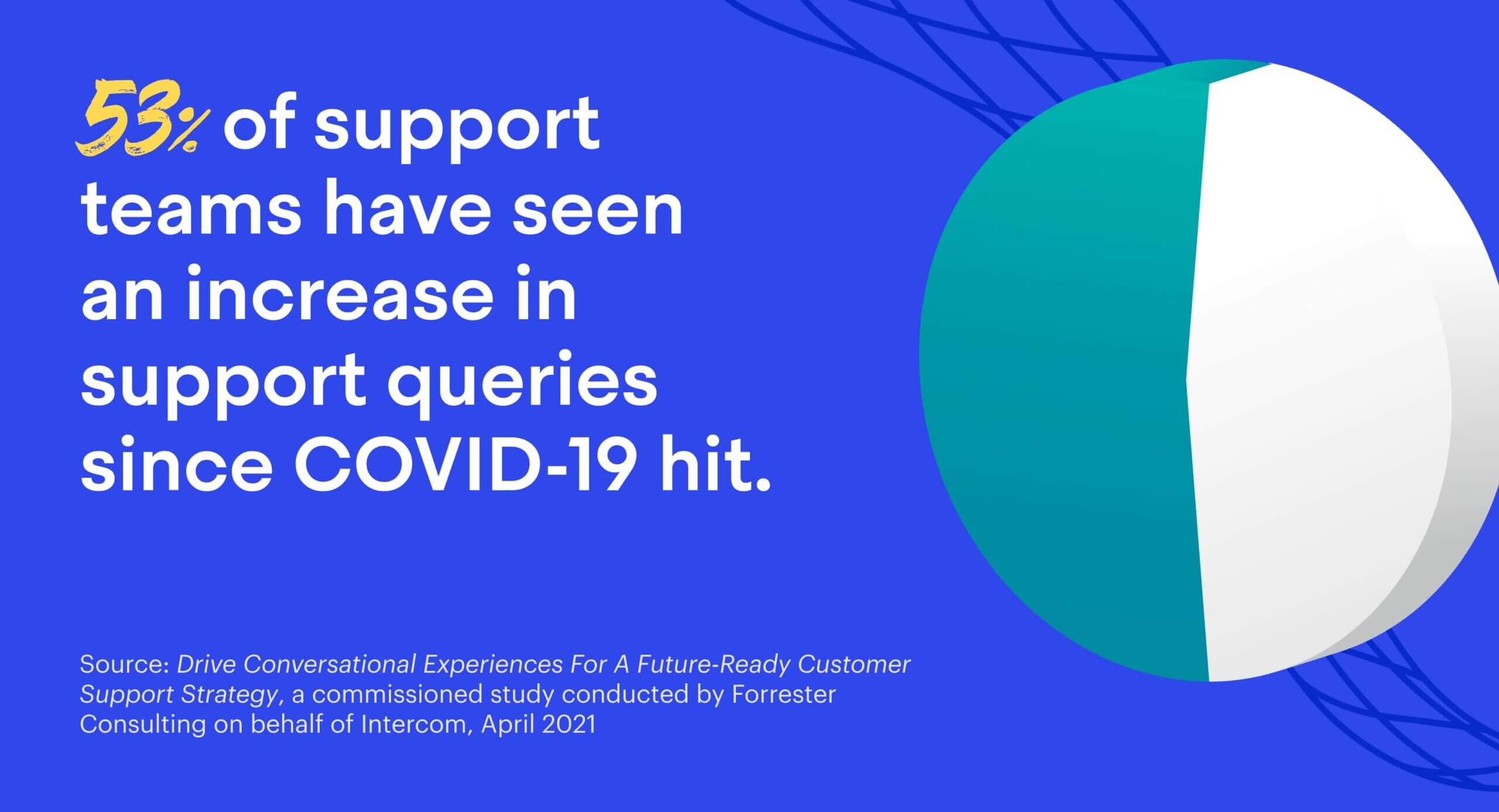
Over half (53%) of support teams have seen a meaningful increase in support queries since COVID-19 hit. Not only that, but 49% say those interactions are highly complex, and 32% report that there have been more emotional customer support interactions.
Managing this influx of customer conversations while still providing efficient, personalized customer experiences is a challenge – especially when 51% of support leaders say that their team has less bandwidth today than ever before. And most significantly, these limitations are having a negative impact on both agent happiness and customer experience.
“As the influx of customer inquiries came in through our support channels, we needed a balanced amount of agents who could support it. Some of our all-star agents were working overtime to manage our email queue to ensure it never got out of control.”
“The most immediate change that took place due to the pandemic was the increased volume of customer or sales queries,” says Austin Guanzon, Overseas Manager and Product Specialist at Dialpad. “As the influx of customer inquiries came in through our support channels, we needed a balanced amount of agents who could support it. Some of our all-star agents were working overtime to manage our email queue to ensure it never got out of control.”
However, as Austin is quick to note, this is unsustainable – and can lead to future problems in the form of agent burnout, which negatively impacts both agent happiness and your customer’s experience.
So how can you manage a larger volume of queries without needing to add headcount?
The solution: Optimize your resources with the Conversational Support Funnel
By implementing messenger-based support and using a strategic framework like the Conversational Support Funnel, you can scale your support without needing to increase budget or add headcount. The Conversational Support Funnel is a messenger-first model that combines proactive, self-serve, and human support, so you can provide fast, efficient, personal support, while also ensuring that your agents can focus their time and resources in the most impactful ways.
For Austin, this meant adding additional self-serve and proactive support resources to effectively assist their customers and free up more time for their support reps to focus on high-impact human support.
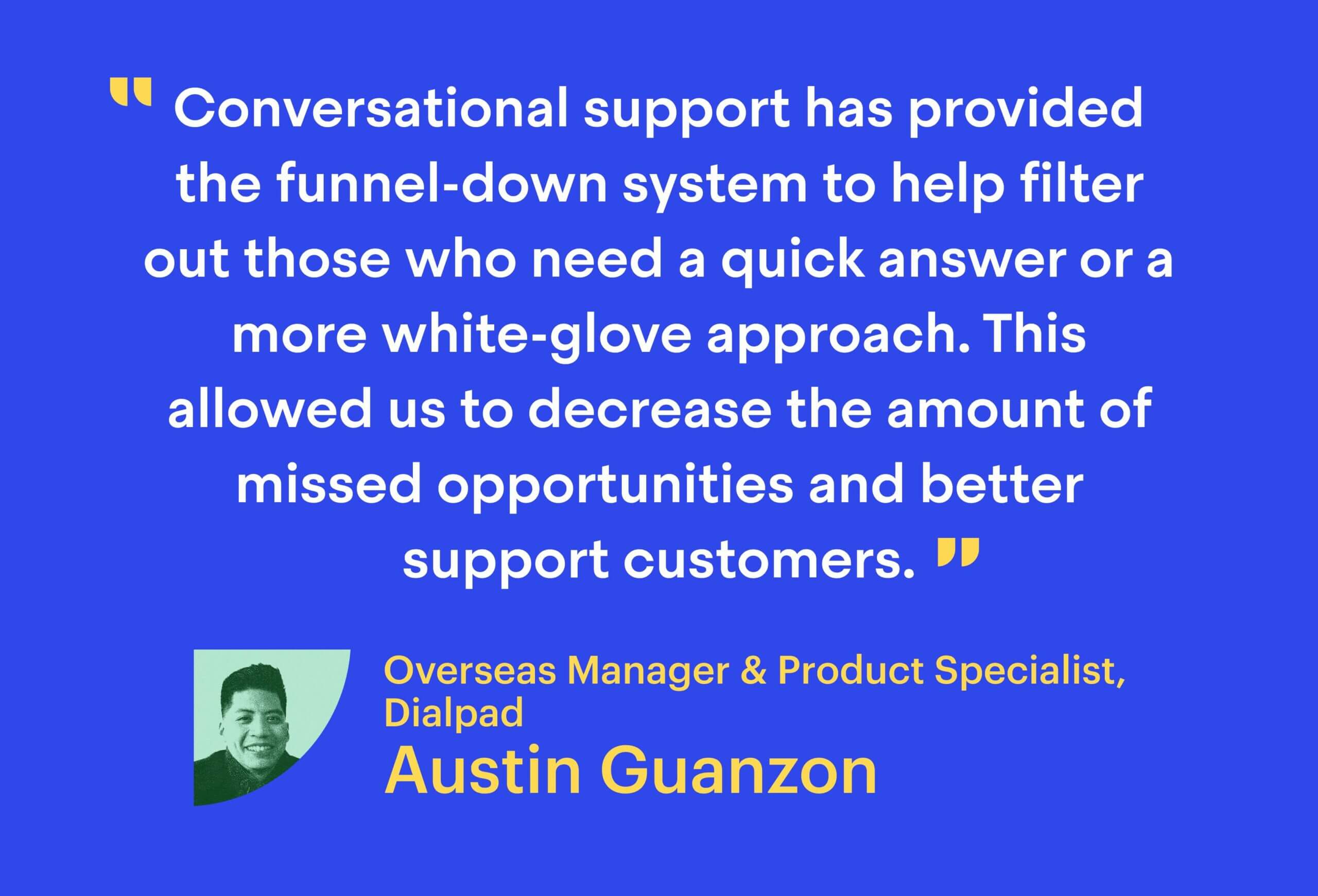
“Conversational support has provided the funnel-down system to help filter out those who need a quick answer or a more white-glove approach,” Austin says. “This allowed us to decrease the amount of missed opportunities and better support customers.”
Pro tip: New to the Conversational Support Funnel? We’ve put together this handy starter kit (including an interactive worksheet) to help you get up and running.
Challenge #2: Agents are wasting time jumping between tools
In addition to bandwidth challenges, Forrester’s research also showed that half of all support teams are wasting time inefficiently switching between various tools and platforms to solve customer issues.
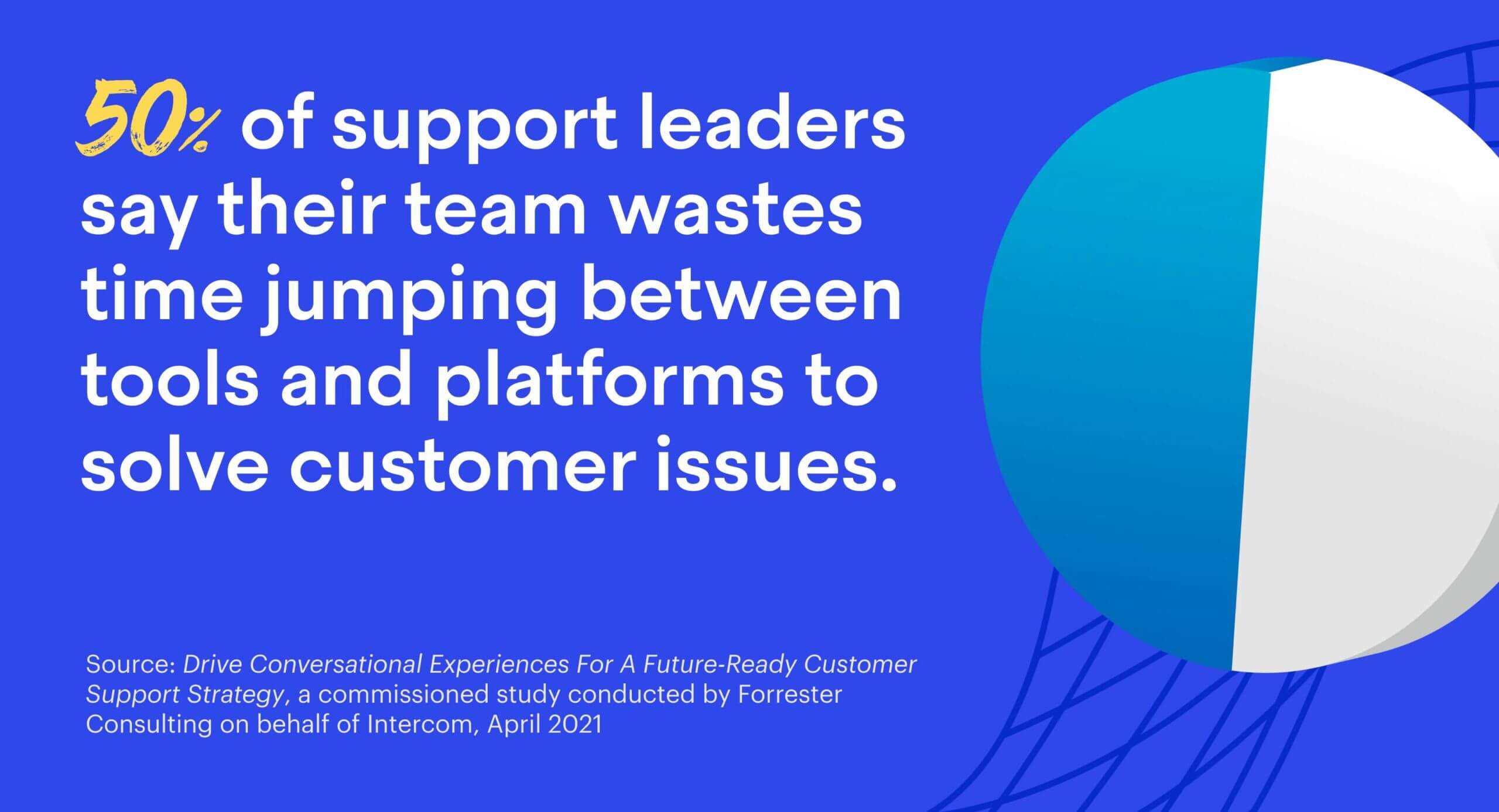
This is often known as the “swivel chair effect,” whereby support reps need to switch between multiple tools and screens to gather all the necessary information and context they need to solve the customer’s problem.
This makes even the simplest query more time-consuming than it should be, but it becomes even more of a time sink as you add more channels or struggle to sustain legacy channels that aren’t as efficient (like phone support).
Losing time due to poor tech stacks is a clear sign that most teams aren’t being equipped with the right tools or processes they need to resolve customer issues in a fast, efficient, personal way. Instead, they’re stuck wrangling tools, not solving problems – and wasting time that could be spent connecting with customers.
The solution: A tool that gives you a holistic view of of the entire customer journey
Instead of scrambling between multiple channels and tools to try and get the full picture, you need to give your support reps a birds-eye view of the entire customer journey, with rich context into each customer’s specific needs and conversation history.
“Every conversation automatically becomes part of an invaluable database that allows you to tailor and customize your support based on each customer’s requirements and history”
Messenger-based support allows you to do this effortlessly, because each message is searchable, scannable, and taggable. This means that every conversation automatically becomes part of an invaluable database that allows you to tailor and customize your support based on each customer’s requirements and history, as well as recognize trends across the customer experience.
Centralizing all of your customer communications into one tool also creates a better experience for your customers. By having one “point of contact” (that is, your messenger) for all questions, and using bots to collect valuable information upfront, customers experience a friction-free journey. And thanks to automation, all of the work of triaging queries and routing them to the right person happens seamlessly behind the scenes.
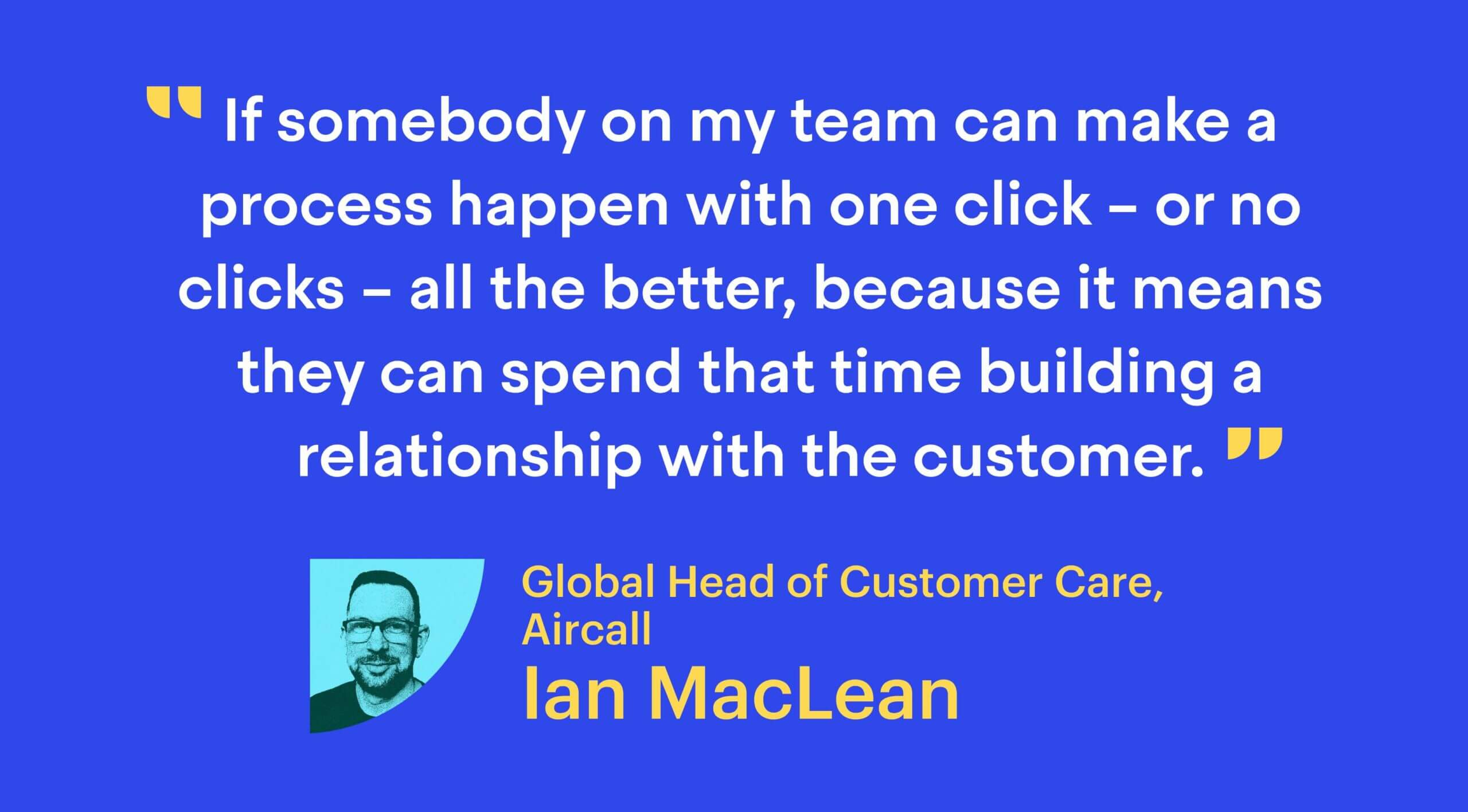
For Ian MacLean, Global Head of Customer Care at Aircall, reducing the swivel chair effect unlocks more time for what really matters. “If somebody on my team can make a process happen with one click – or no clicks – all the better, because it means they can spend that time building a relationship with the customer,” he says.
And when you do need to use other tools? Make sure that they integrate seamlessly to create a tech stack that works harder for you.
Challenge #3: Your team is stuck on the reactive support treadmill
Some 49% of support leaders say that their team spends time answering repetitive questions. That’s right – 49% of support leaders say that their team spends time answering repetitive questions. That’s almost half of all support leaders whose teams spend time answering repetitive questions.
See how frustrating that is? Now imagine it day in and day out.
“Answering the same questions over and over again can feel like Groundhog Day for your support reps”
Answering the same questions over and over again can feel like Groundhog Day for your support reps. It eats up large chunks of that aforementioned precious time and bandwidth that could be spent in more productive (not to mention more fulfilling) ways, like solving complex problems or dealing with emotionally charged issues.
Forrester’s research found that many teams are still stuck on the reactive support treadmill. That means that they’re answering questions one-by-one as they come in, instead of using proactive support to get ahead of known queries before they even become issues.
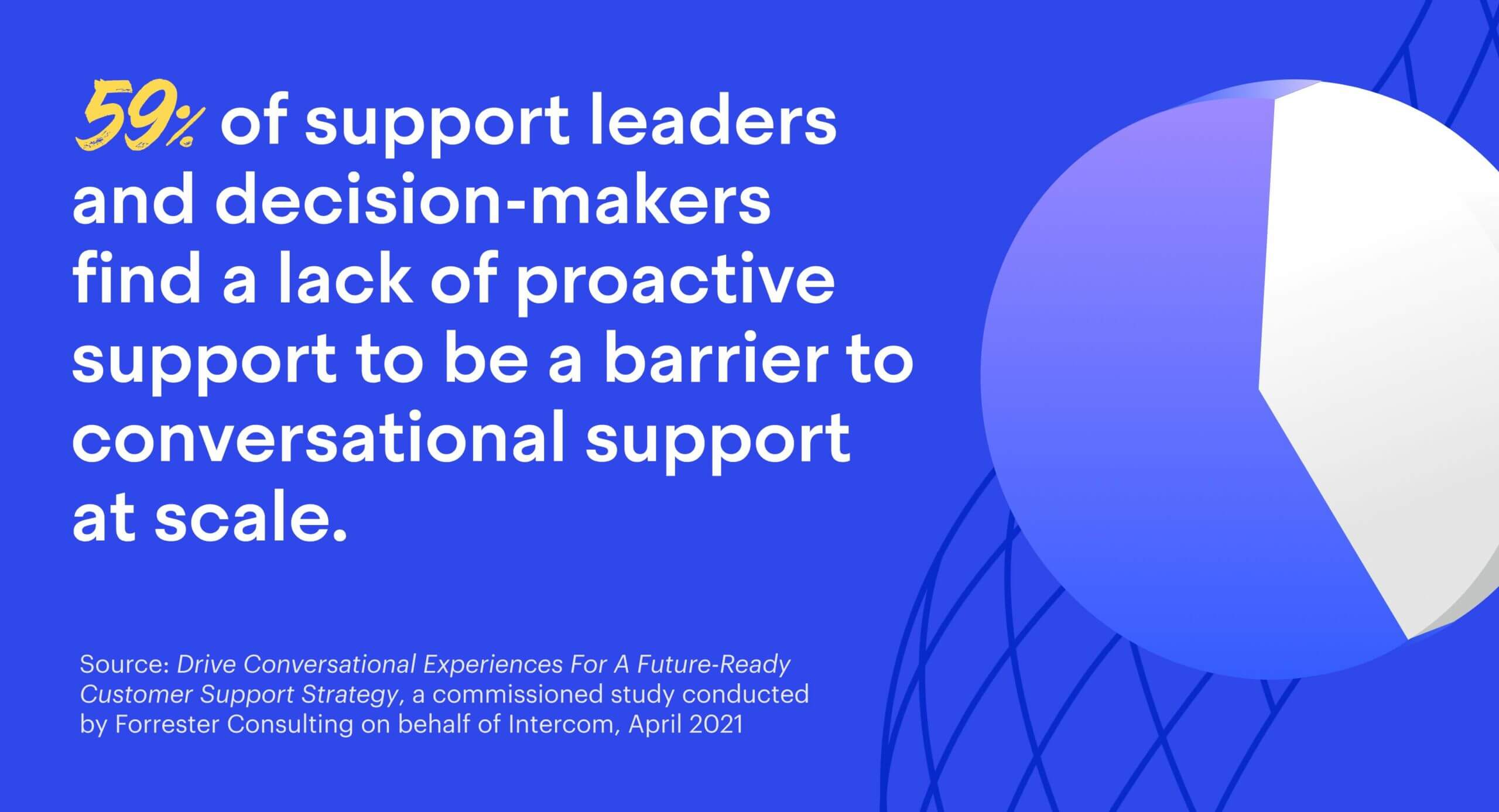
Proactive support is an essential part of the Conversational Support Funnel, so it makes sense that 59% of support leaders and decision-makers find a lack of proactive support to be a barrier to providing conversational support at scale.
And without the right tool to empower proactive support, support reps remain trapped on the treadmill, unable to form the kind of conversational, personalized relationships that allow them to make a real impact to your business’s bottom line.
The solution: Make the switch from reactive to proactive support
According to our recent report, The Future of Support Has Arrived: It’s Conversational, 78% of support leaders want to move from a reactive to a proactive support approach, but only 26% are confident that they have the knowledge and tools to do so.
Providing proactive support requires a two-pronged approach: to do it right, you need both the right mindset and the right technology. First, you need to actively look for ways to improve the customer’s journey, and preemptively identify recurring customer issues. Then, you need to use the right conversational support tool to help you address those issues at exactly the right time.
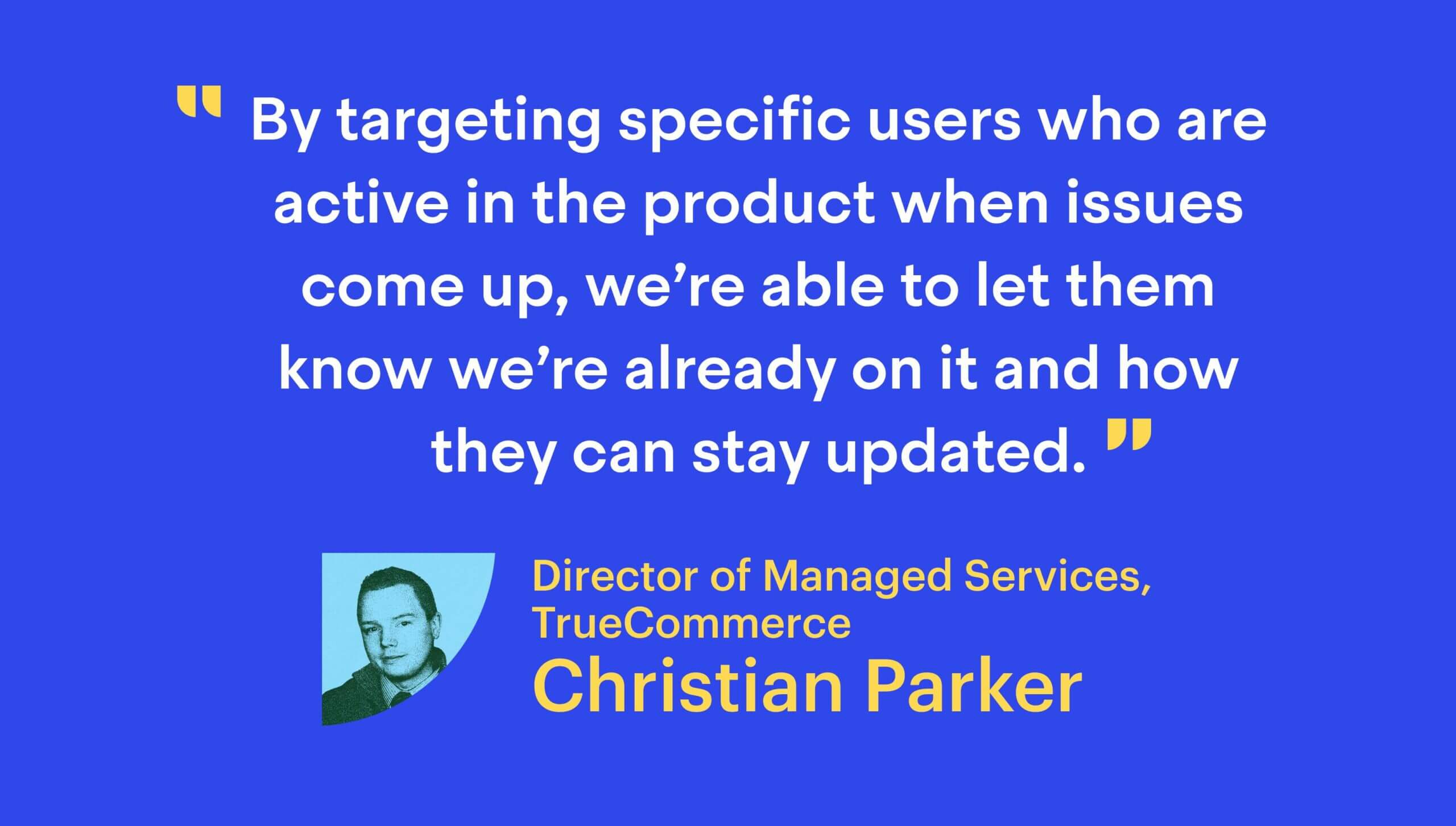
The results speak for themselves. For TrueCommerce, proactive support has reduced their inbound conversation volume by 20%. They’ve also seen an 80% reduction in contacts when temporary issues arise, because they’ve already been able to identify and inform affected customers proactively.
As Christian Parker, Director of Managed Services at TrueCommerce, explains, “By targeting specific users who are active in the product when issues come up, we’re able to let them know we’re already on it and how they can stay updated.”
Challenge #4: Your business isn’t getting the customer insights it needs
Forrester’s research found that over half (52%) of the support leaders surveyed believe that they’re lacking the technology and tools to leverage customer conversations for actionable insights. That means that they don’t have visibility over things that would help them to improve the customer experience and deliver more personalized support at scale.
Currently, only 37% of support leaders feel confident that their organization’s tech stack can help them analyze trends and produce insights to optimize next-best-action decisions for consumers. Similarly, only 34% say that their tech stack automatically detects issues with the customer support experience that negatively impact business results.
The solution: A tool that allows you to capture (and dig in to) the right information
We’ve already seen how inefficient tooling can contribute to this problem. But even when you have the raw data, you need to be able to leverage it in the right way in order to actually make a difference.
“Look for a tool that not only captures the important information, but also allows you to dig into it to discover important trends”
So you need to look for a tool that not only captures the important information, but also allows you to dig into it to discover important trends. For example, by using a tool that leverages machine learning to surface insights, you can identify key topics for your customers and stay ahead of the curve.
It’s also important to be able to quickly and efficiently track how your team is performing against key metrics, so you know whether you’re on par with industry standards and delivering the high-quality experience your customers expect. Look for something with customizable, visual dashboards that allow you to create custom reports. This means that you can create unique dashboards that give you instant overviews of the things that matter most to your team and your business, such as customer happiness, so you can ensure you’re always working towards the right goals.
With the right insights, you can spot opportunities for improvement, supercharge your growth, and scale your support.
